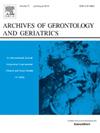NICERGOLINE IN THE TREATMENT OF DIZZINESS IN ELDERLY PATIENTS. A REVIEW
IF 3.5
3区 医学
Q2 GERIATRICS & GERONTOLOGY
引用次数: 0
尼麦角林在治疗老年头晕患者中的应用。复习一下。
在老年患者中,头晕经常发生,对患者的生活产生重大影响。它的频率随着年龄的增长而增加,并且可能由多种原因引起。老年患者的慢性失衡很可能与中枢神经系统紊乱有关,这可能是由于神经元功能改变或潜在的血管疾病引起的。尼哥林是一种用于治疗老年患者认知障碍的药物,可改善老年痴呆和非痴呆患者的头晕症状。在一项双盲安慰剂对照试验中,该药改善了(i)头晕评估评定量表(DARS)测量的症状严重程度,(ii)总体印象量表显示的总体临床状况,以及(iii)头晕障碍量表(DHI)估计的感知生活质量。这些结果表明,姿势测量也可能产生积极影响。此外,这种改善发生在没有牺牲既定姿势控制策略的情况下,这表明这种效果是由一种替代代偿机制介导的,使患者能够保持巩固的姿势策略。此前对大约3000名患者进行的公开临床研究结果与这些发现一致。总的来说,症状的严重程度降低了68%(对照研究为57%)。在全球范围内,结果表明尼麦角林对中枢源性平衡障碍相关症状有有益作用。动物实验表明,该药物在细胞和分子机制上表现出广泛的作用。此外,专门针对前庭病理生理的动物研究表明,尼麦角碱可以改善前庭病变模型的前庭代偿。尼麦角碱慢性治疗可改善老年大鼠半迷路切除术后行为恢复的时间过程,并抵消老年大鼠病变后观察到的胆碱能受体的调节。从分子水平到认知功能,尼科角碱在多个层面上通过多种机制相互作用,可能增强了中枢前庭代偿机制下的自发可塑性现象。这种作用不是依赖于与单一递质识别的神经通路的相互作用,而是来自几个大脑区域的解剖、功能和神经化学协同调节。
本文章由计算机程序翻译,如有差异,请以英文原文为准。
求助全文
约1分钟内获得全文
求助全文
来源期刊
CiteScore
7.30
自引率
5.00%
发文量
198
审稿时长
16 days
期刊介绍:
Archives of Gerontology and Geriatrics provides a medium for the publication of papers from the fields of experimental gerontology and clinical and social geriatrics. The principal aim of the journal is to facilitate the exchange of information between specialists in these three fields of gerontological research. Experimental papers dealing with the basic mechanisms of aging at molecular, cellular, tissue or organ levels will be published.
Clinical papers will be accepted if they provide sufficiently new information or are of fundamental importance for the knowledge of human aging. Purely descriptive clinical papers will be accepted only if the results permit further interpretation. Papers dealing with anti-aging pharmacological preparations in humans are welcome. Papers on the social aspects of geriatrics will be accepted if they are of general interest regarding the epidemiology of aging and the efficiency and working methods of the social organizations for the health care of the elderly.

 求助内容:
求助内容: 应助结果提醒方式:
应助结果提醒方式:


